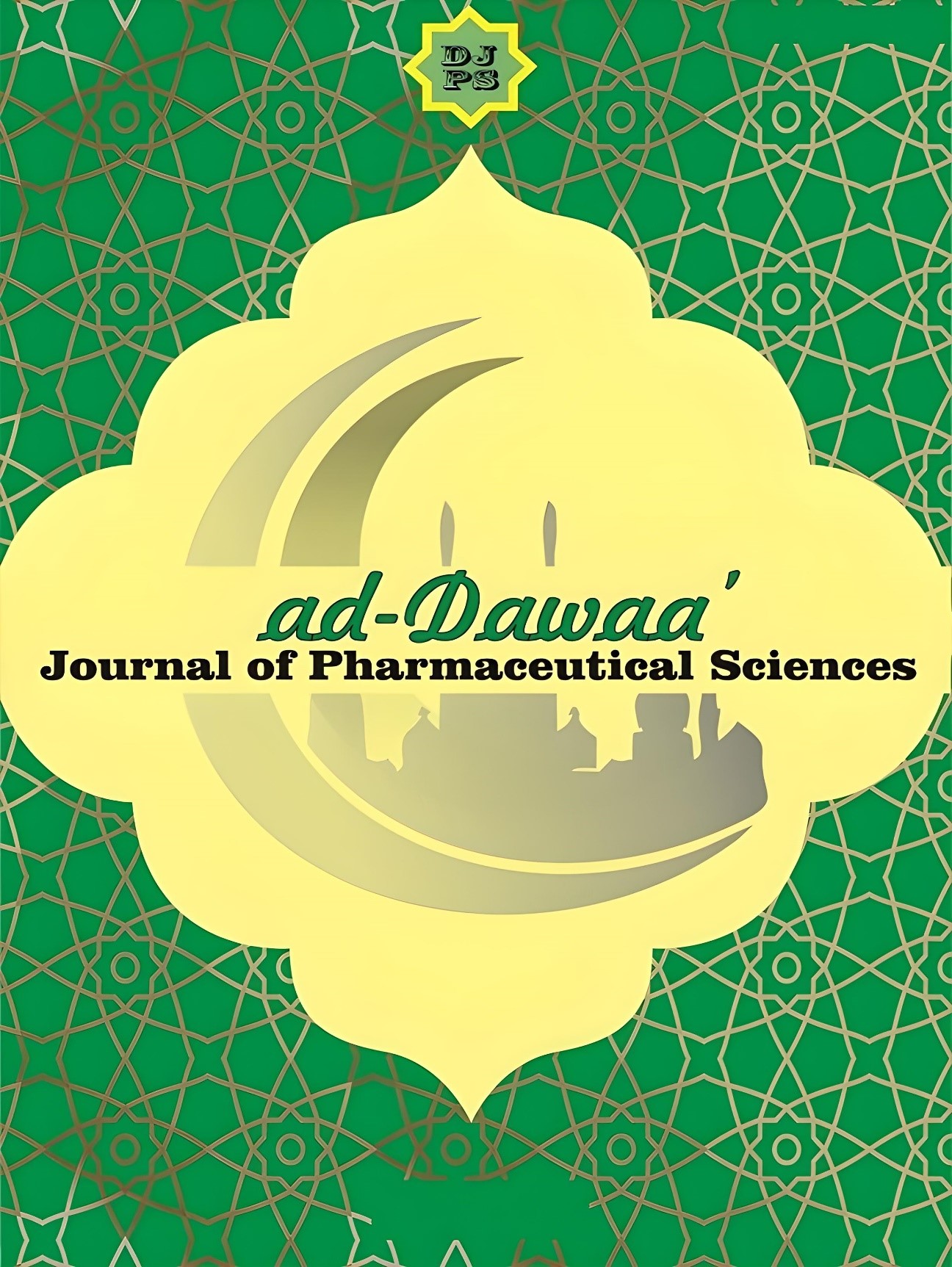Comparison of Caffeine Compound Levels in Brewed and Boiled Oolong Tea Leaves (Camellia sinensis (L.) Kuntze) Based on Different Processing Methods
DOI:
https://doi.org/10.24252/djps.v8i1.54457Keywords:
Caffeine, tea, brewed, boiled, UV-Vis spectrophotometryAbstract
Introduction: Tea contains many compounds that are beneficial for the body, namely caffeine. The process of brewing tea with a time and temperature that is not optimal can affect the caffeine content in it. And the brewing process by heating can widen the distance between the molecules in the tea. The higher the temperature and the longer the brewing time, the higher the caffeine content.. Aims: This study aims to analyze the caffeine content of brewed and boiled oolong tea, then compare the caffeine content of oolong tea with brewing (without heating) and boiled (with heating) processes. Methods: The research method used is experimental. This study used dried samples of oolong tea leaves (Camellia sinensis (L.) Kuntze). Quantitative analysis using UV-Vis Spectrophotometry. Result: Quantitatively, the caffeine content in brewed oolong tea was 3.522% w/w and the caffeine content in boiled oolong tea was 4.001% w/w. The conclusion of this study is that there is no significant difference in caffeine levels in brewed and boiled oolong tea with a significant value of P> 0.05.
Downloads
References
Agustina Styawan, A., Arrosyid, M., (2023.). Perbandingan Kadar Kafein Pada Teh Hitam (Camellia Sinensis) Yang Diseduh dan Direbus Dengan Metode Titrasi Bebas Air. Program Studi DIII Farmasi Universitas Muhammadiyah Klaten.
Annuryanti, F., Zahroh, M., & Purwanto, D. A. (2018). Pengaruh Suhu dan Jumlah Penyeduhan terhadap Kadar Kafein Terlarut dalam Produk Teh Hijau Kering dengan Metode KCKT. Jurnal Farmasi Dan Ilmu Kefarmasian Indonesia, 5(1), 30. https://doi.org/10.20473/jfiki.v5i12018.30-35
Artanti, A. N., Nikmah, W. R., Setiawan, H., & Prihapsara, F. (2016). Perbedaan Kadar Kafein Daun Teh (Camellia sinensis (L.) Kuntze) Berdasarkan Status Ketinggian Tempat Tanam Dengan Metode HPLC. Journal of Pharmaceutical Science and Clinical Research, 01(01), 37–44. https://doi.org/10.20961/jpscr.v1i1.690
Atmaja, R. E. D. D., & Kurniawati, F. (2018). Perilaku Konsumsi Teh di Kecamatan Wonosari Kabupaten Gunung Kidul Provinsi Daerah Istimewa Yogyakarta. Advanced Optical Materials, 10(1), 1–9.
Danasrayaningsih, V. S. (2015). Penetapan Kadar Kafein Dalam Minuman Berenergi Merek “X” Dengan Metode Spektrofotometri Derivatif Aplikasi Peak-To-Peak. Universitas Sanata Dharma, 3, 4–5.
Dewi, J. K., Purwijantiningsih, L. M. E., & Pranata, F. S. (2016). Kualitas Teh Celup Dengan Kombinasi Teh Oolong dan Daun Stevia (Stevia rebaudiana bertonii). Jurnal Ilmu Dan Teknologi Pangan (ITEPA), 4–23.
Fajriana, N. H., & Fajriati, I. (2018). Analisis Kadar Kafein Kopi Arabika (Coffea ara-
bica L.) pada Variasi Temperatur Sangrai. Analit: Analytical and Environmental Chemistry, 3 (02), 148–162.
Irawati, D., Agustina Styawan, A., Nurhaini, R., (2018). Penetapan Kadar Kafein Pada Teh Oolong (Camellia sinensis) Dengan Metode Titrasi Bebas Air. Program Studi DIII Farmasi STIKES Muhammadiyah Klaten. The 7 th University Research Colloqium 2018 STIKES PKU Muhammadiyah Surakarta.
Maramis, R. K., Citraningtyas, G., & Wehantouw, F. (2013). Analisis Kafein Dalam Kopi Bubuk di Kota Manado Menggunakan Spektrofotometri UV-Vis. Pharmacon Jurnal Ilmiah Farmasi-Unsrat, 2 (04).
Novita, L., & Aritonang, B. (2017). Penetapan Kadar Kafein pada Minuman Berenergi Sediaan Sachet yang Beredar di Sekitar Pasar Petisah Medan. Jurnal Kimia Saintek Dan Pendidikan, I (1), 37–42.
Putri, D. D., & Ulfin, I. (2015). Pengaruh Suhu dan Waktu Ekstraksi Terhadap Kadar Kafein Dalam Teh Hitam. Jurnal Sains dan Seni ITS, 4(2), 2337–3520.
Raharjo, R. A. (2010). Penentuan Kadar Kafein Dalam Kopi. Universitas Haluoleo.
Rahayuningsih, D. (2014). Pengaruh Suhu dan Waktu Penyeduhan Teh Celup Terhadap Kadar Kafein. Universitas Muhammadiyah Surakarta.
Romandhoni, A. N., & Arrosyid, M. (2018). Penetapan Kadar Kafein pada Teh Oolong (Camellia sinensis) Menggunakan Ekstraksi Refluk Dengan Metode Titrasi Bebas Air. CERATA Jurnal Ilmu Farmasi (Journal of Pharmacy Science), 48–55.
Styawan, A. A., & Atun Yuliana. (2024). Comparison of Tannin Levels in Brewed and Boiled Green Tea (Camellia sinensis (L.) Kuntze) by UV-Vis Spectrophotometric Method. Ad-Dawaa’ Journal of Pharmaceutical Sciences, 103–108. https://doi.org/10.24252/djps.v7i2.42618
Suryadi, H., Kurniadi, M., & Melanie, Y. (2010). Analisis Formalin Segar dari Pasar Muara Angke. Majalah Ilmu Kefarmasian, VII (3), 16–31.
Susanti, H., Araaf, N. P. M., & Kusbandari, A. (2020). Perbandingan Metode Spektrofotometri UV dan HPLC pada Penetapan Kadar Kafein dalam Kopi. Majalah Farmasetika., 4 (Suppl 1), 28–33. https://doi.org/10.24198/mfarmasetika.v4i0.25887
Wardani, R. K., & Ferry Fernanda, M. A. H. (2016). Analisis Kadar Kafein dari Serbuk Teh Hitam, Teh Hijau dan Teh Putih (Camellia sinensis L.). Journal of Pharmacy and Science, 1(1), 15–17. https://doi.org/10.53342/pharmasci.v1i1.48
Yonata, A., & Saragih, D. G. P. (2016). Pengaruh Konsumsi Kafein pada Sistem Kardiovaskular. Jurnal Majority, 5 (3), 43–49.
Zarwinda, I., & Sartika, D. (2019). Pengaruh Suhu dan Waktu Ekstraksi Terhadap Kafein Dalam Kopi. Lantanida Journal, 6(2), 180. https://doi.org/10.22373/lj.v6i2.3811 Sintyadewi, R. P., & Widnyani, I. A. P. A. (2021). The Influence of Fermentation Time on the Total Flavonoid and Organoleptic Test of Black Tea Kombucha and Butterfly Pea (Clitoria ternatea L.) Infusion. Media Ilmiah Teknologi Pangan (Scientific Journal of Food Technology), 8(2), 72–77.
Utami, N., Susianti, S., Bakri, S., Kurniawan, B., & Setiawansyah, A. (2023). Cytotoxic activity of Cyperus rotundus L. rhizome collected from three ecological zones in Lampung-Indonesia against HeLa cervical cancer cell. Journal of Applied Pharmaceutical Science, 13(10), 141–148. https://doi.org/10.7324/JAPS.2023.113764
Zhao, Y. S., Eweys, A. S., Zhang, J. Y., Zhu, Y., Bai, J., Darwesh, O. M., Zhang, H. B., &
Xiao, X. (2021). Fermentation affects the antioxidant activity of plant-based food material through the release and production of bioactive components. Antioxidants, 10(12). https://doi.org/10.3390/antiox10122004
Downloads
Published
How to Cite
Issue
Section
License
Copyright (c) 2025 Anita Agustina Styawan, Aristhasari Putri, Ocha Ardela Fitria Kresnaya

This work is licensed under a Creative Commons Attribution-ShareAlike 4.0 International License.
Once an article was published in the journal, the author(s) are:
- granted to the journal right licensed under Creative Commons License Attribution that allows others to share the work with an acknowledgement of the work's authorship.
- permitted to publish their work online in third parties as it can lead to wider dissemination of the work.
- continue to be the copyright owner and allow the journal to publish the article with the CC BY-SA license
- receiving a DOI (Digital Object Identifier) of the work.







1.png)
